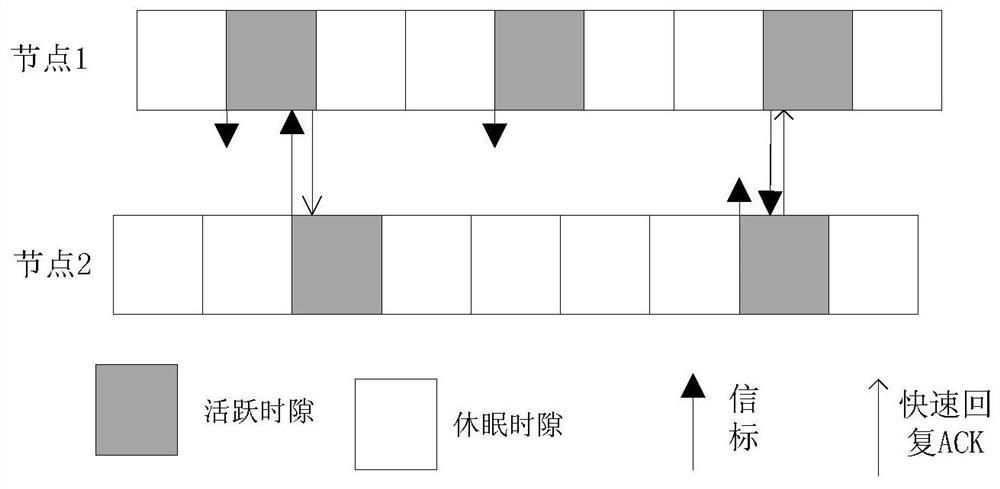A Fast Response Communication Mechanism in Slot-Based Neighbor Discovery Protocol
A fast response and discovery protocol technology, applied in the direction of using the return channel for error prevention/detection, digital transmission systems, electrical components, etc., can solve the problem of increased discovery delay, too little overlapping of active time slots, beacon redundancy, etc. problem, to achieve the effect of reducing the discovery delay and ensuring fast discovery
- Summary
- Abstract
- Description
- Claims
- Application Information
AI Technical Summary
Problems solved by technology
Method used
Image
Examples
Embodiment 1
[0023] see figure 2 , Node 2 sends a beacon to Node 1 at the beginning of the active time slot, and Node 1 immediately parses some bits in the frame control field after receiving the beacon, and if it is confirmed that it is a beacon frame, it quickly replies ACK to Node 2 . After receiving the ACK sent by node 1, node 2 completes the two-way discovery between the two nodes.
[0024] The beacon sending period is figure 2 The T1 period in , including the process of the beacon grouping at the Mac layer, transmitting to the bottom layer until the beacon is sent out, has a size of about 2 milliseconds.
[0025] The time period for receiving beacons and replying ACK quickly is figure 2 In T3, its size is about 0.5 milliseconds. The time period for receiving ACK is figure 2 In T2, its size is about 1 millisecond.
[0026] Therefore, under the fast-response communication mechanism, to complete the mutual discovery of both nodes, the two nodes need to overlap at least the ti...
Embodiment 2
[0028] see image 3 , to send beacons at the beginning and end of the node's active slots. Node 2 sends a beacon to node 1 at the beginning of the active time slot, which takes time T1; node 1 receives the beacon when it takes T2; then node 1 sends a beacon to node 2, and after node 2 receives the beacon, the two nodes complete each other Find.
[0029] The time to receive the beacon is image 3 In the T2 period, the size is about 1 millisecond.
[0030] Therefore, under the communication mechanism of head-to-tail transmission in active time slots, to complete mutual transmission between two nodes, the active time slots of the nodes must overlap at least two T1 times plus one T2 time, that is, 5 milliseconds.
[0031] Analyze the probability of mutual discovery when the active time slots of two nodes meet under the fast response communication mechanism, assuming that the overlapping time length of the active time slots of the two nodes is uniformly changed, that is, the ove...
Embodiment 3
[0035] see Figure 5 , in the experiment, under 5% duty cycle, two nodes run the Disco protocol, input 500 sets of data, and get the discovery delay of each set of data. The graphical results show that the fast response communication mechanism can improve the average discovery delay of the protocol compared with the mechanism of sending at the beginning and end of the slot.
[0036] Analyze another improved performance of the fast response mechanism compared with the first-to-end beacon sending mechanism. The node runs in single-duplex mode. If it sends a beacon, it cannot receive data. The more time the node takes to send the beacon, the listening time will be shorter. It will be reduced. For the same protocol running at the same time, the mechanism of sending beacons at the beginning and the end will send two beacons in each active time slot, while the mechanism of fast response will only send one beacon in each active time slot when there are no neighbors around. Beacon, a...
PUM
 Login to View More
Login to View More Abstract
Description
Claims
Application Information
 Login to View More
Login to View More - R&D
- Intellectual Property
- Life Sciences
- Materials
- Tech Scout
- Unparalleled Data Quality
- Higher Quality Content
- 60% Fewer Hallucinations
Browse by: Latest US Patents, China's latest patents, Technical Efficacy Thesaurus, Application Domain, Technology Topic, Popular Technical Reports.
© 2025 PatSnap. All rights reserved.Legal|Privacy policy|Modern Slavery Act Transparency Statement|Sitemap|About US| Contact US: help@patsnap.com



